Sir John Monash, Personal Files Book 5, 25 May - 10 June 1915, Part 9
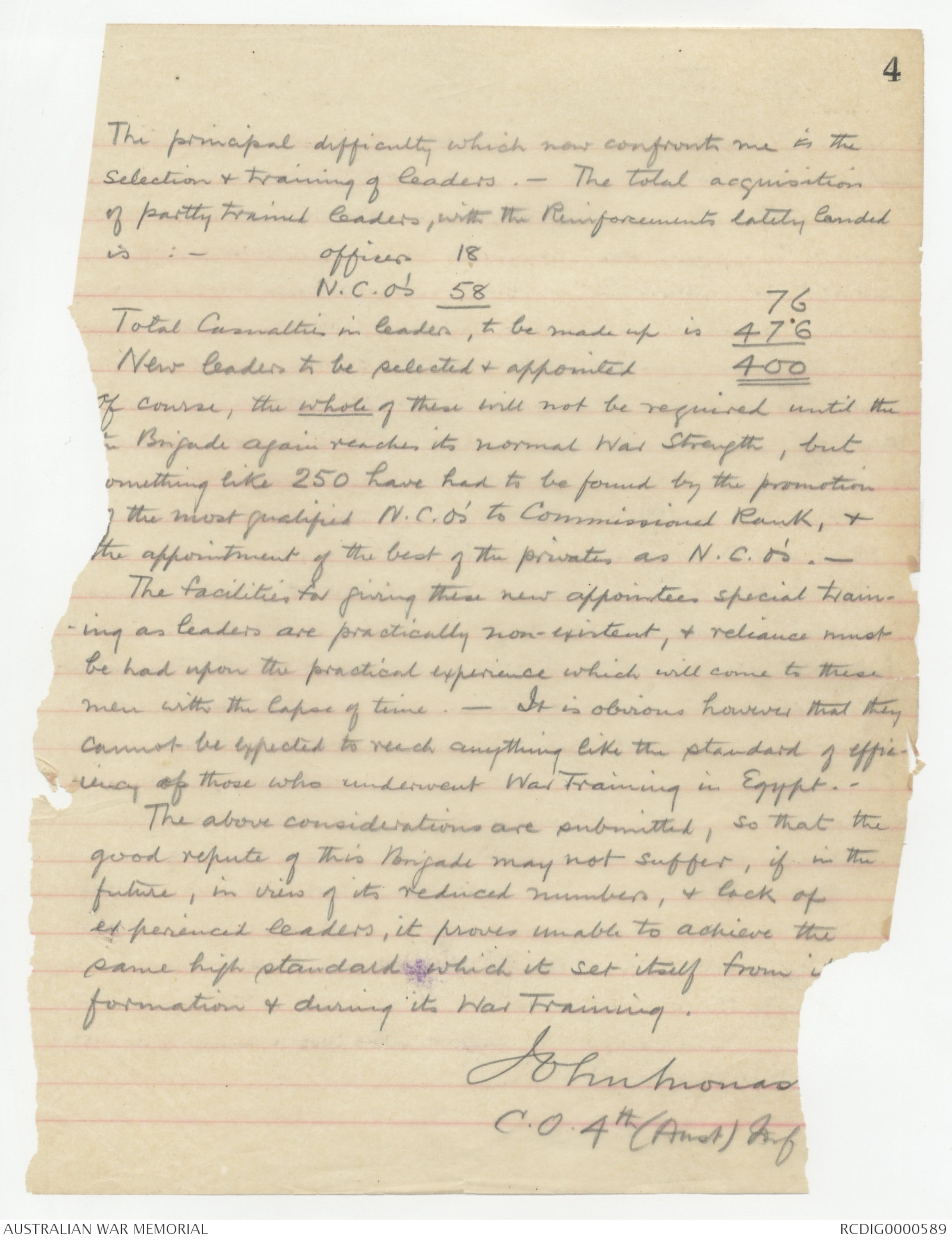
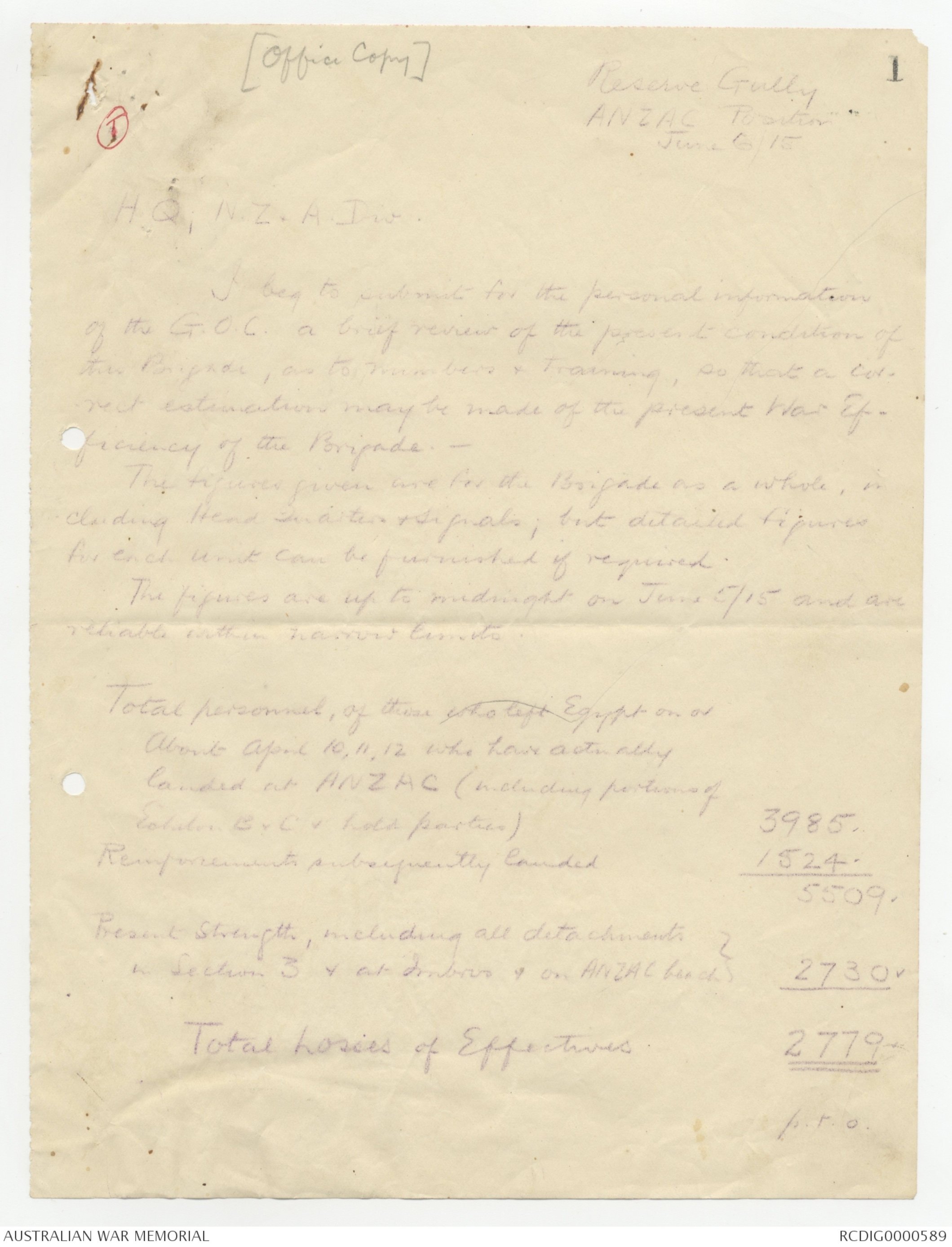
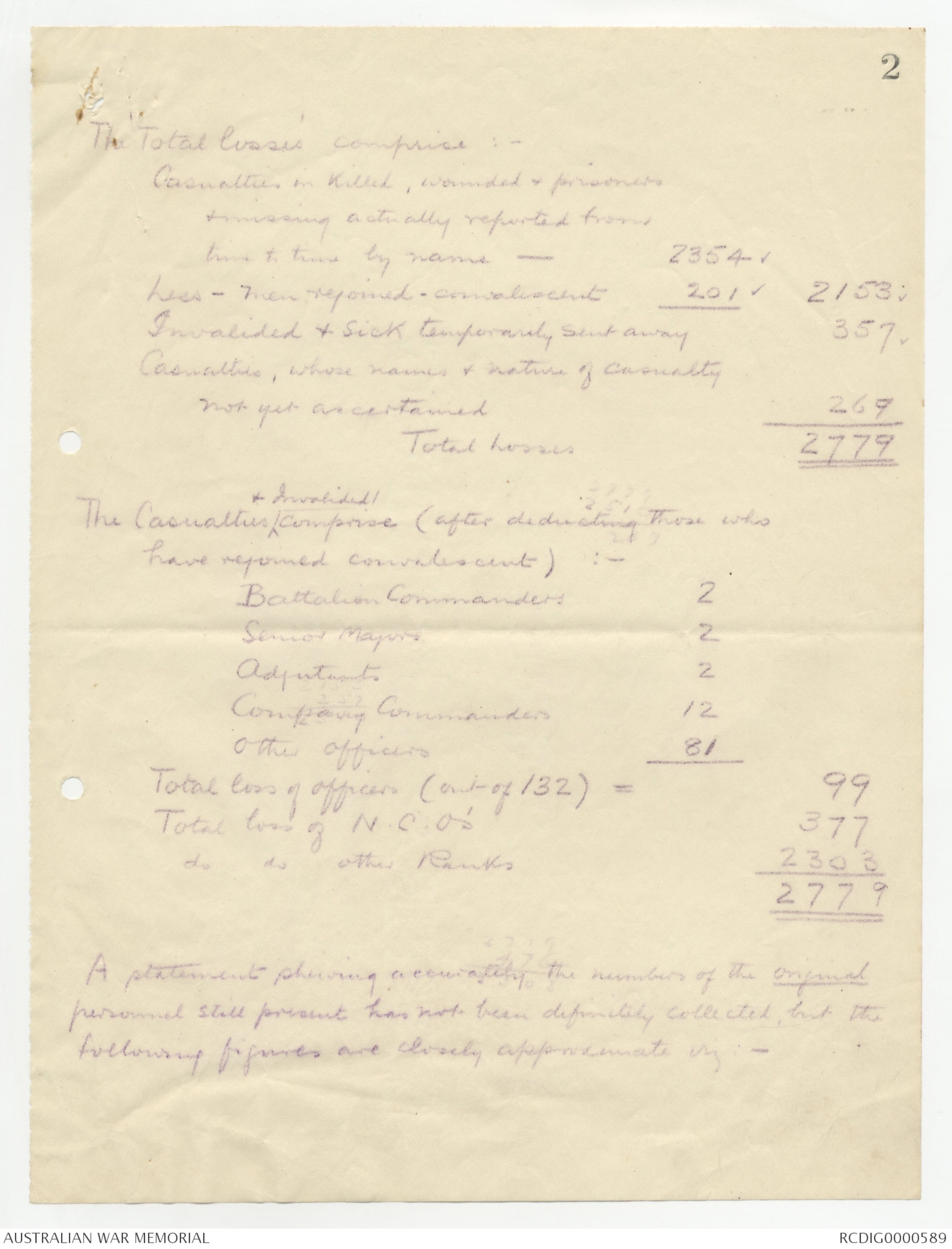
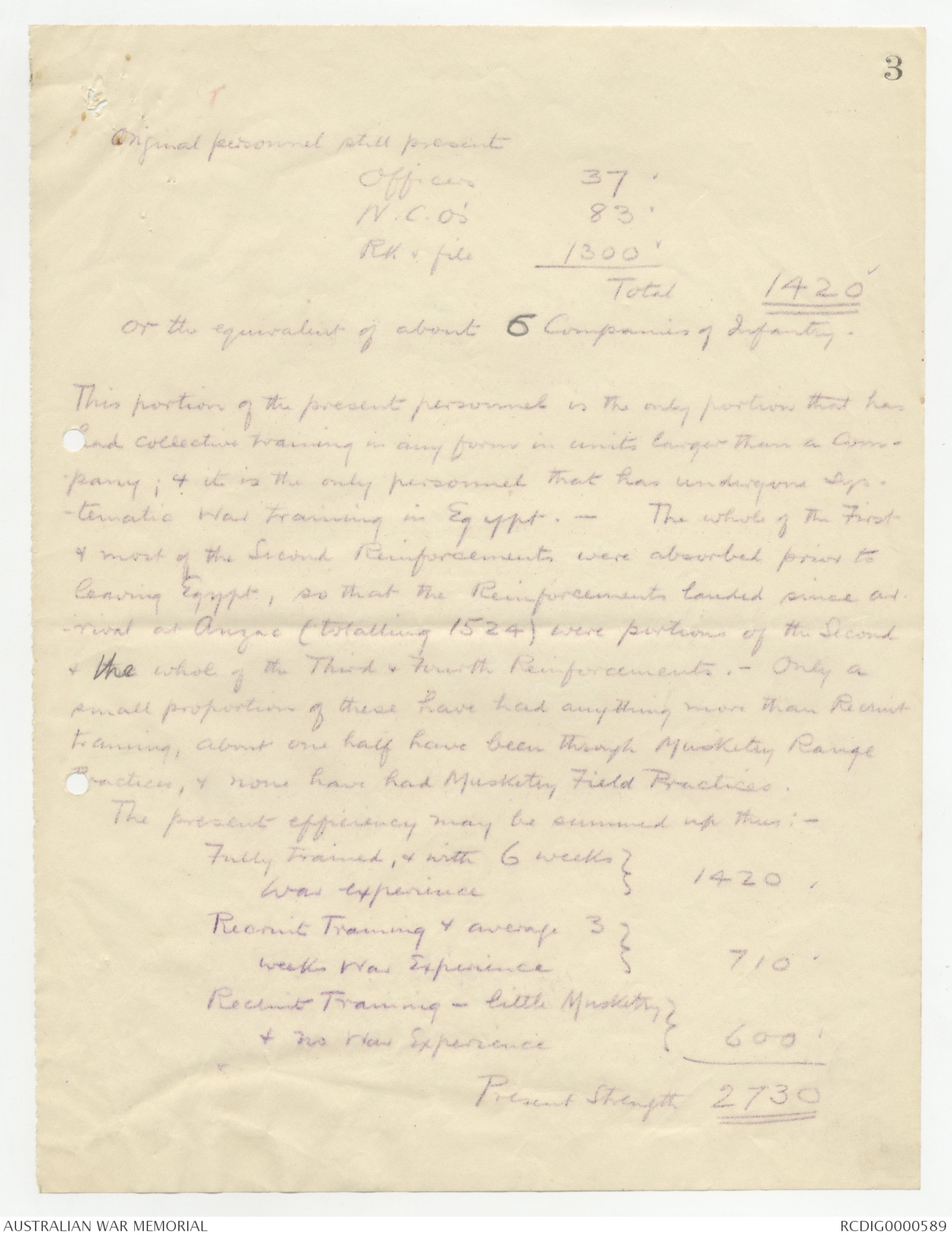


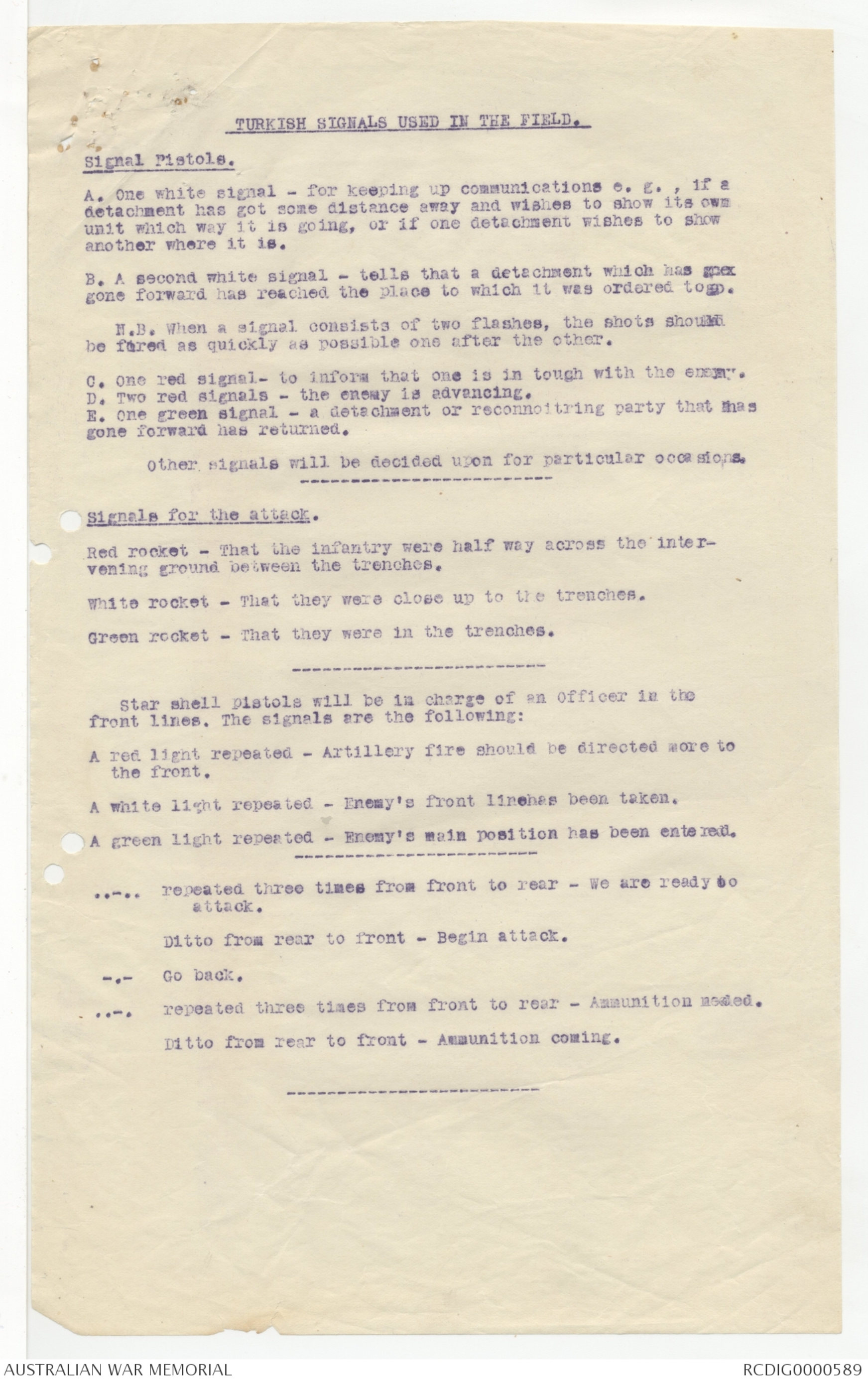
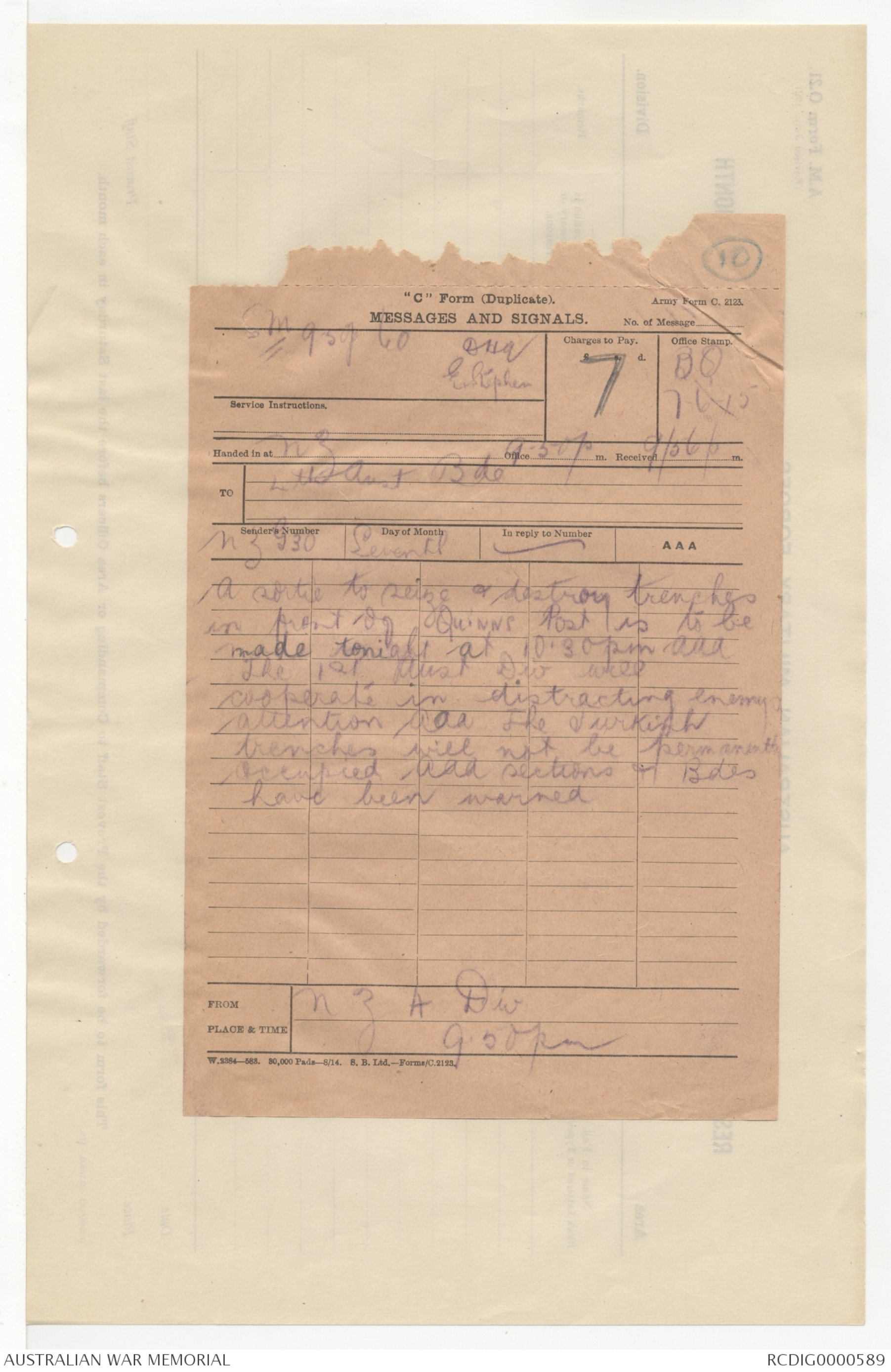

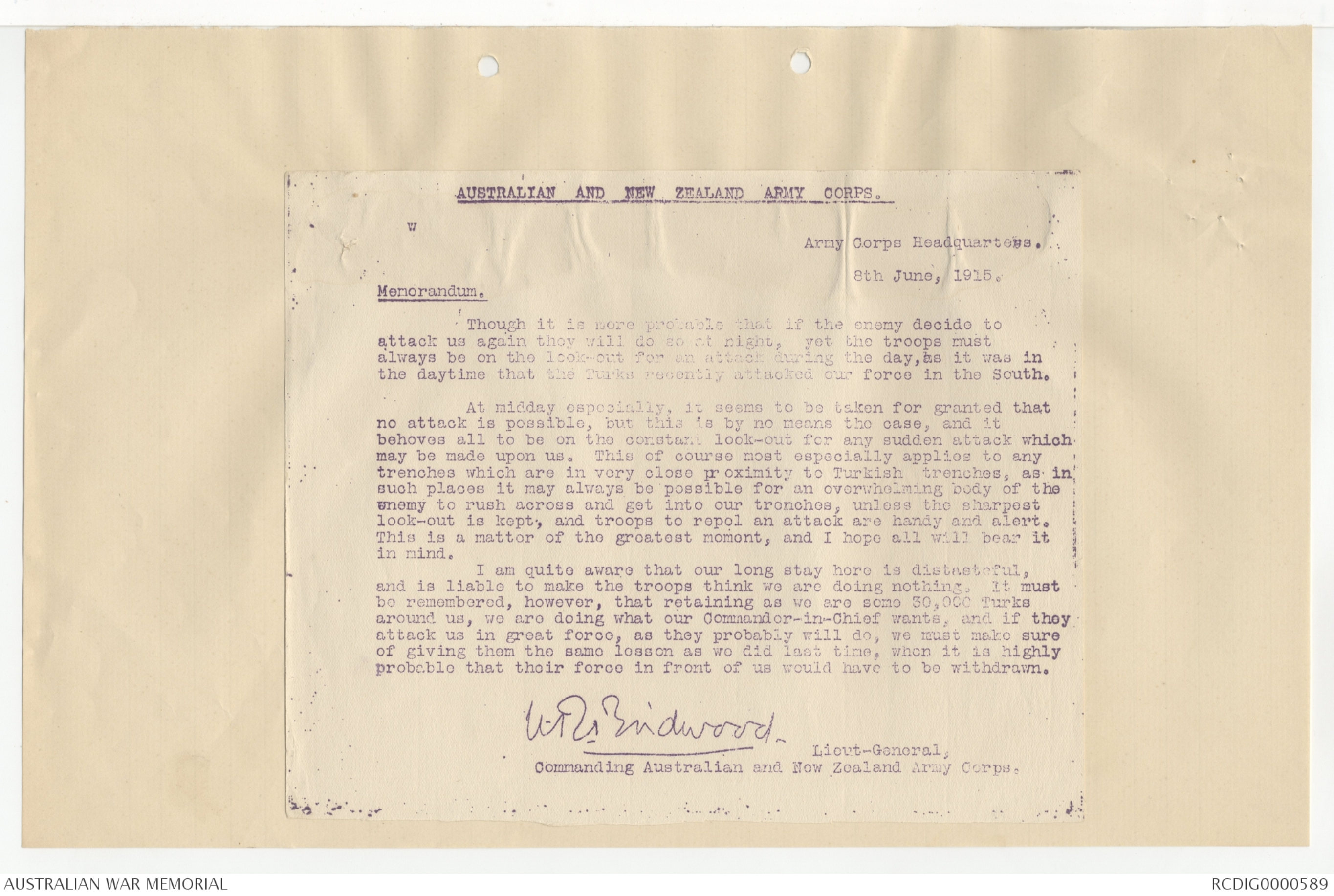
4
The principal difficulty which now confronts me is the
selection & training of leaders. - The total acquisition
of partly trained leaders, with the Reinforcements lately landed
is:- officers 18
N.C.O's 58 76
Total Casualties in leaders, to be made up is 476
New leaders to be selected & appointed 400
Of course, the whole of these will not be required until the
Brigade again reaches its normal War Strength, but
something like 250 have had to be found by the promotion
of the most qualified N.C.O's to Commissioned Rank, &
the appointment of the best of the privates as N.C.O's. -
The facilities for giving these new appointees special training
as leaders are practically non-existent, & reliance must
be had upon the practical experience which will come to these
men with the lapse of time. - It is obvious however that they
cannot be expected to reach anything like the standard of efficiency
of those who underwent War Training in Egypt. -
The above considerations are submitted, so that the
good repute of this Brigade may not suffer, if in the
future, in view of its reduced numbers, & lack of
experienced leaders, it proves unable to achieve the
same high standard which it set itself from its
formation & during its War Training.
John Monash
C.O. 4th (Aust) Inf
T [Office Copy] 1
Reserve Gully
ANZAC Position
June 6/15
H.Q, N.Z.A. Div.
I beg to submit for the personal information
of the G.O.C. a brief review of the present condition of
the Brigade, as to numbers & training, so that a correct
estimation may be made of the present War Efficiency
of the Brigade. -
The figures given are for the Brigade as a whole, including
Head Quarters & Signals; but detailed figures
for each unit can be furnished if required.
The figures are up to midnight on June 5/15 and are
reliable within narrow limits.
Total personnel, of those who left Egypt on or
About April 10, 11, 12 who have actually
landed at ANZAC (including portions of
Echelon B & C & hold parties) 3985
Reinforcements subsequently landed 1524
5509
Present strength, including all detachments}
in Section 3 & at Imbros & on ANZAC beach} 2730
Total Losses of Effectives 2779
p.t.o.
2
The Total losses comprise:-
Casualties in killed, wounded & prisoners
& missing actually reported from
time to time by name - 2354
Less - men rejoined - convalescent 201 2153
Invalided & sick temporarily sent away 357
Casualties, whose names & nature of casualty
not yet ascertained 269
Total Losses 2779
The Casualties ∧& Invalided comprise (after deducting those who
have rejoined convalescent) : -
Battalion Commanders 2
Senior Majors 2
Adjutants 2
Company Commanders 12
Other officers 81
Total loss of officers (out of 132) = 99
Total loss of N.C.O's 377
do do other Ranks 2303
2779
A statement showing accurately the numbers of the original
personnel still present has not been definitely collected, but the
following figures are closely approximate viz :-
3
Original personnel still present
Officers 37 ✓
N.C.O's 83 ✓
Rk & file 1300 ✓
Total 1420 ✓
or the equivalent of about 6 Companies of Infantry.
This portion of the present personnel is the only portion that has
had collective training in any form in units larger than a Company;
& it is the only personnel that have undergone systematic
War training in Egypt. - The whole of the First
& most of the Second Reinforcements were absorbed prior to
leaving Egypt, so that the Reinforcements landed since arrival
at Anzac (totalling 1524) were portions of the Second
& the whole of the Third & Fourth Reinforcements. - Only a
small proportion of these have had anything more than Recruit
training, about one half have been through Musketry Range
Practices, & none have had Musketry Field Practices.
The present efficiency may be summed up thus:-
Fully Trained, & with 6 weeks }
War experience } 1420
Recruit Training & average 3 }
weeks War Experience } 710
Recruit Training - little Musketry }
& no War Experience } 600
Present Strength 2730
T 4
The principal difficulty which now confronts me is the
selection & training of leaders. - The total acquisition
of partly trained leaders, with the Reinforcements lately landed
is:- officers 18
N.C.O's 58 76
Total Casualties in leaders, to be made up is 476
New leaders to be selected & appointed 400
Of course, the whole of these will not be required until [[the?]]
the Brigade again reaches its normal War Strength, but
something like 250 have had to be found by the promotion
of the most qualified N.C.O's to Commissioned Rank, &
the appointment of the best of the privates as N.C.O's. -
The facilities for giving these new appointees special training
as leaders are practically non-existent, & reliance must
be had upon the practical experience which will come to these
men with the lapse of time. - It is obvious however that they
cannot be expected to reach anything like the standard of efficiency
of those who underwent War Training in Egypt. -
The above considerations are submitted, so that the
good repute of this Brigade may not suffer, if in the
future, in view of its reduced numbers, & lack of
experienced leaders, it proves unable to achieve the
same high standard which it set itself from its
formation & during its War Training.
John Monash Col.
C.O. 4th (Aust) Inf. Bgde
HEADQUARTERS,
N.Z. & A. DIVISION.
ANZAC COVE.
June 7th 1915.
4/Aust. Inf. Bde.
Herewith Turkish signals used in the field: these
are continually altered, and are different for different
forces, but this list may possibly be of use to units.
C. Shaire Major.
General Staff.
N.Z & A. Divn
TURKISH SIGNALS USED IN THE FIELD.
Signal Pistols.
A. One white signal - for keeping up communications e. g. , if a
detachment has got some distance away and wishes to show its own
unit which way it is going, or if one detachment wishes to show
another where it is.
B. A second white signal - tells that a detachment which has goex
gone forward has reached the place to which it was ordered to go.
N.B. When a signal consists of two flashes, the shots should
be fired as quickly as possible one after the other.
C. One red signal- to inform that one is in touch with the enemy.
D. Two red signals - the enemy is advancing.
E. One green signal - a detachment or reconnoitring party that has
gone forward has returned.
Other signals will be decided upon for particular occasions.
-----------------------
Signals for the attack.
Red rocket - That the infantry were half way across the intervening
ground between the trenches.
White rocket - That they were close up to the trenches.
Green rocket - That they were in the trenches.
-----------------------
Star shell pistols will be in charge of an Officer in the
front lines. The signals are the following:
A red light repeated - Artillery fire should be directed more to
the front.
A white light repeated - Enemy's front linehas been taken.
A green light repeated - Enemy's main position has been entered.
-----------------------
..-.. repeated three times from front to rear - We are ready to
attack.
Ditto from rear to front - Begin attack.
-.- Go back.
..-. repeated three times from front to rear - Ammunition needed.
Ditto from rear to front - Ammunition coming.
(10)
"C" Form (Duplicate) Army Form C. 2123.
MESSAGES AND SIGNALS. No. of Message...
SM 9.5 of 60 DHQ Charges to Pay Office Stamp
E. Stephen £ s. d. BQ
Service Instructions. 7 7.6.15
Handed in at NZ Office 9.50 pm Recieved 9/56pm
TO 4th Aust Bde
Sender's Number Day of Month In reply to Number
NZ 930 Seventh -- AAA
A sortie to seize & destroy trenches
in front of QUINNS Post is to be
made tonight at 10.30 pm AAA
The 1st Aust Div will
cooperate in distracting enemys
attention AAA The Turkish
trenches will not be permanently
occupied AAA Sections & Bdes
have been warned.
FROM N Z A Div
PLACE & TIME 9.50 pm
W.2384-583. 30,000 Pads-8/14. S. B. Ltd.-Forms/C.2123.
AUSTRALIANS IN TRENCHES.
Age June 8/15
Mined by the Turks.
Section of Trench Captured.
How the Enemy Was Ejected.
[FROM CAPTAIN C. E. W. BEAN, OFFICIAL
REPORTER WITH THE AUSTRALIAN
FORCES.]
[COPYRIGHT RESERVED BY CROWN.]
(By Cable from Alexandria.)
GALLIPOLLI, 29th May.
The enemy, although reinforced since the
attack on 19th May, has not made a further
general attack. He has been tunnelling
for days against portion of our
line where the trenches approach within
ten yards of each other, and are indeed
at one point actually connected by a communication
trench. Our engineers twice
during the week countermined and blew
in the enemy's tunnel. Last night the
enemy's third tunnel was known to be
a few feet away, and early in the
morning the enemy blew up a mine beneath
our trench. Some of our men were
thrown to the ground half stunned by the
explosion, but none apparently was killed.
Then strange gruff voices were heard just
outside the trench, and the Turks immediately
began a perfect shower of hand
grenades into this short length of trench.
They also got into a small portion of the
trench from which our men had drawn
aside. Probably fifty Turks dropped into
the trench without much difficulty in the
confusion and under the dust of the explosions.
Once there the Turks found themselves
in a short length of trench, divided from
our men in the same trench on one side
by a mound of earth thrown up by the
explosion, and on the other by a traverse
of trench. From that time the position
of the invaders was worse than if they
had never arrived in the trench, as they
were unable to do anything except throw
a few bombs among our men, who were
hemming them in. Their fate became
every minute more certain.
This portion of the line happened at
the time to be held by Australians of the
Second Contingent, who, with the exception
of the first few days of the landing,
had been subjected probably to the
severest strain of any portion of the force.
Shortly after sunrise the enemy attempted
to charge to reinforce the isolated men in
our trench. Our infantry was waiting, and
they charged over the trench to meet
them, but the Turks did not wait! Our
men then attacked the Turks in the trench
with hand grenades, and about 7.30 a.m.
they charged with the bayonet over the
parapet. It happened that at this moment
the Turks were making a second attempt
to reinforce their men, but the Australians-
some coolly standing at their full
height in the open-shot them down, and
few Turks, if any, regained their lines.
Our men retook the trench.
Presently, however, it was discovered
that portion of the connecting trench
in this dark rabbit warren was occupied
by some person who was barricading himself,
and would not allow anyone to pass.
Some thought he was a Turk, and others
thought he might be an Australian who
imagined that the Turks were still in the
trench around him. A partition was
quickly built against him, and when he
was found to be a Turk he was immediately
attacked. Being bombed by us
from the sides, and by fellow Turks from
the rear, he surrendered. It turned out
that there were seventeen Turks in the
hole, and they walked down through the
lines of our men, who slapped them on the
back and gave them cigarettes. Some of
the Third Contingent also took part in this
fighting.
Our troops determined to retain the
trenches intact at whatever cost. Only
on one previous occasion had any Turks
ever entered an Australian trench, and
that was during the attack on 19th May,
when seven Turks dropped into the same
portion of the trench during the confusion
following the explosion of bombs.
Our troops in the same trench held them
from one side while they were shot down
from the other. Only one man managed
to jump out of the trench, and he ran
down our side of the slope, and fell exhausted
from wounds inside our lines.
It is estimated that the enemy has now
lost 3000 killed and at least 6000 wounded
that day. Their loss at any rate was very
heavy. The enemy's losses last night probably
totalled 300. Every day a sprinkling
of Turkish soldiers gave themselves up,
racing along the beach or dropping hurriedly
into the trenches. They often attempt
to kiss our officers' hands.
THE REPORTED ATROCITIES.
The conditions of the burial armistice the
other day were on the whole very honorably
observed. Our wounded in the
enemy's hands are said to be well cared
for. A few stories of atrocities are current,
and they may reach Australia. I
can only say that the principal one which
I have tested proved wholly untrue. Some
dum dum bullets have been picked up, but
the stories of explosive bullets are quite
without foundation, and are due to the
men misunderstanding the curious double
crack of the Mauser rifle. Some of the
wounds are terrible, and I would have put
them down to expanding bullets had I not
seen wounds quite as terrible in the heads
of Turks lying just outside of our
trenches.
The New Zealanders captured a trench
on our left last night. A party of the
Australian Ninth Battalion also made a
sortie. and bayoneted the Turkish snipers
in a trench far beyond our right, and returned
without casualty, largely owing to
a bombardment by a destroyer.
----------------------------------------------------
RED, ROUGH HANDS MADE SOFT AND
WHITE.-For red, rough, chapped and bleeding
hands, dry, fissured, itching, burning palms and
painful finger ends, with shapeless nails, a one-
night Cuticura treatment works wonders. Directions:-
Soak the hands, on retiring, in hot water
and Cuticura Soap. Dry, anoint with Cuticura
Ointment, and wear soft bandages, or old, loose
gloves during the night. These pure, sweet and
gentle emollients preserve the hands, prevent
redness, roughness and chapping, and impart in
a single night that velvety softness and whiteness
so much desired by women. For those whose occupations
tend to injure the hands, Cuticura Soap
and Cuticura Ointment are wonderful. Although
Cuticura Soap and Ointment are sold throughout
the world, a sample of each, with 32-page Skin
Book, will be mailed free on application to
R. Towns and Co., Dept. T., Sydney, N.S.W,-
[Advt.]
AUSTRALIAN AND NEW ZEALAND ARMY CORPS.
W
Army Corps Headquarters.
8th June, 1915.
Memorandum.
Though it is more probable that if the enemy decide to
attack us again they will do so at night, yet the troops must
always be on the look-out for an attack during the day, as it was in
the daytime that the Turks recently attacked our force in the South.
At midday especially, it seems to be taken for granted that
no attack is possible, but this is by no means the case, and it
behoves all to be on the constant look-out for any sudden attack which
may be made upon us. This of course most especially applies to any
trenches which are in very close proximity to Turkish trenches, as in
such places it may always be possible for an overwhelming body of the
enemy to rush across and get into our trenches, unless the sharpest
look-out is kept, and troops to repel an attack are handy and alert.
This is a matter of the greatest moment, and I hope all will bear it
in mind.
I am quite aware that our long stay here is distasteful,
and is liable to make the troops think we are doing nothing. 1t must
be remembered, however, that retaining as we are some 30,000 Turks
around us, we are doing what our Commander-in-Chief wants, and if they
attack us in great force, as they probably will do, we must make sure
of giving them the same lesson as we did last time, when it is highly
probable that their force in front of us would have to be withdrawn.
W.R. Birdwood.
Lieut-General,
Commanding Australian and New Zealand Army Corps.
 Jacqueline Kennedy
Jacqueline KennedyThis transcription item is now locked to you for editing. To release the lock either Save your changes or Cancel.
This lock will be automatically released after 60 minutes of inactivity.